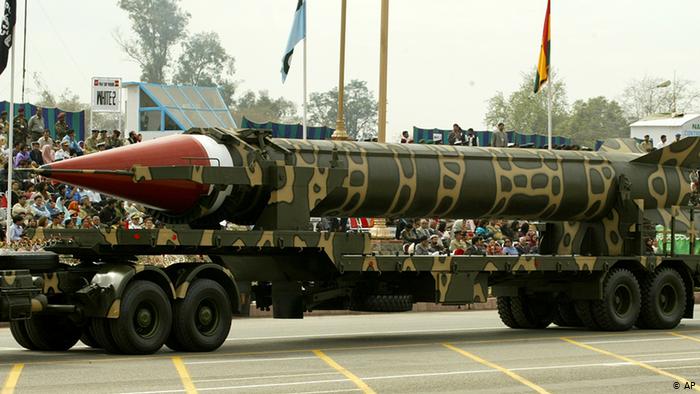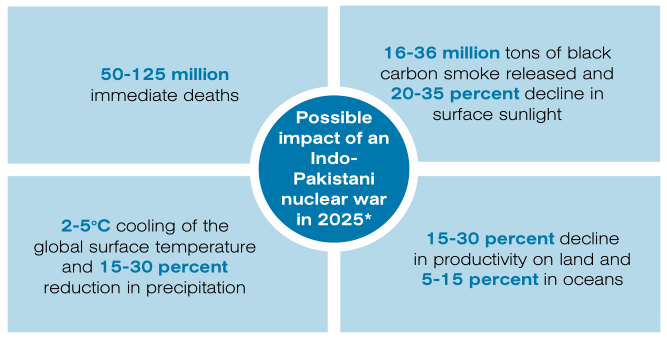The Munich Security Conference, citing numerous reports and surveys, also looked into the potential of a regional nuclear conflict between India and Pakistan.
There is no concrete evidence that such a conflict is nearing, however, tensions have been soaring between New Delhi and Islamabad, after India’s removal of Kashmir and Jammu’s special status, as well as the controversial Citizenship Amendment Act, which are argued to step all over the human rights of Muslims.
A regional conflict, based on based on an estimate of nuclear arsenals in 2025, this scenario assumes that India uses 100 and Pakistan 150 strategic nuclear weapons with yields from 15 to 100 kilotons to attack urban centers
The situation is the following:
The graph is based on a research article by Owen B. Toon and others, published on October 2nd, 2019 in Science Advances.
The title is: “Rapidly expanding nuclear arsenals in Pakistan and India portend regional and global catastrophe.”
The situation is worrying is potentially concerning because:
“Pakistan and India may have 400 to 500 nuclear weapons by 2025 with yields from tested 12- to 45-kt values to a few hundred kilotons.
If India uses 100 strategic weapons to attack urban centers and Pakistan uses 150, fatalities could reach 50 to 125 million people, and nuclear-ignited fires could release 16 to 36 Tg of black carbon in smoke, depending on yield.
The smoke will rise into the upper troposphere, be self-lofted into the stratosphere, and spread globally within weeks. Surface sunlight will decline by 20 to 35%, cooling the global surface by 2° to 5°C and reducing precipitation by 15 to 30%, with larger regional impacts.
Recovery takes more than 10 years. Net primary productivity declines 15 to 30% on land and 5 to 15% in oceans threatening mass starvation and additional worldwide collateral fatalities.”
Essentially, Pakistan and India have a large amount of the world’s nuclear warheads, but it still is much lower than that of Russia and the US, which account for 93% of the world’s estimated 13,900 nuclear warheads.
Pakistan has nuclear-capable aircraft (F-16A/B and Mirage III/V) with ranges up to 2100 km, eight types of land-based ballistic missiles with possible ranges up to 2750 km, and two types of cruise missiles with ranges up to 350 km.
All of India can be reached by the longest-range delivery systems. Since India has about 400 cities with more than 100,000 people, Pakistan could potentially attack slightly more than one-third of all moderate- and large-sized cities in India with its current arsenal and more than two-thirds by 2025.
Satellite images of locations for 10 facilities in Pakistan suggest that they may be locations of missile garrisons or nuclear-capable fighter-bombers.
Pakistan is developing capabilities for sea-based nuclear weapons. According to Pakistani officials, Pakistan’s weapons are disassembled, and the parts are stored in several separate locations to reduce the possibility that terrorists might capture a usable weapon.
Pakistan has produced tactical nuclear weapons for use on battlefields to counter the conventional weapons advantage of an invading Indian army. Their current arsenal probably includes 24 tactical weapons of unknown yield, but perhaps in the range of 5 to 12 kt.
India has nuclear-capable aircraft including Mirage 2000H and Jaguar IS/IB, with ranges up to 1850 km.
It has four types of land-based ballistic missiles that have been deployed with ranges up to 3200 km and two others that are under development with ranges up to 5200 km.
The range of these missiles allows India to reach all of Pakistan now, as well as all of China when its new missiles are deployed. India also has one deployed ship-based ballistic missile and two submarine-based missiles in development.
Since Pakistan has about 60 cities with more than 100,000 people, India could potentially attack each moderate- or large-sized city in Pakistan with two nuclear warheads using its current arsenal and four warheads if its arsenal grows to 250 weapons by 2025.
Regardless of the abovementioned, both Islamabad and New Delhi are unlikely to engage in a nuclear conflict without substantial provocation.
India has declared a policy of no first use of nuclear weapons, except in response to an attack with biological or chemical weapons.
Pakistan has declared that it would only use nuclear weapons if it could not stop an invasion by conventional means or if it were attacked by nuclear weapons.
But India and Pakistan have had four conventional wars – 1947, 1965, 1971, and 1999. There have been many smaller-scale skirmishes since the partition of British India in 1947.
“Many scenarios of an India-Pakistan conflict in 2025 are possible, ranging from no nuclear weapons deployed to as many as 500 nuclear weapons—many with yields above 100 kt—detonated. We chose the scenario outlined in table S1 as plausible following advice from a number of military and policy experts.
In addition, the information presented in this paper and the Supplementary Materials can be used as a basis to compute the results for other scenarios. The main determinants of casualties and climate effects are the number of weapons used, the yield of the weapons, and the targets for the weapons, each of which is unknown in advance.”
Essentially, there’s little concern that a nuclear war between the two neighbors would begin anytime soon, but the research is a thorough look into how two sides with nuclear capability, not even closely as powerful as that of the US or Russia, could lead to near-cataclysmic events globally that would, in the short term cause hundreds of millions of deaths, and likely billions in the long term.
MORE ON THE TOPIC:







